Ever wondered why some Magento stores seem to effortlessly turn visitors into customers while others struggle to make sales?
The secret isn’t just about having a well-designed Magento store or a high-quality product range. It lies in the art of Conversion Rate Optimization (CRO), a real game-changer that can turn any Magento merchant’s casual browsers into committed buyers. And the best part? It’s not as complicated as you might think.
This blog article will help unlock the power of 10+ Magento Conversion Rate Optimization strategies to boost your online sales and enhance user experience.
Keep reading to discover how these tested strategies can transform your site visitors into loyal customers.
Understanding Conversion Rate Optimization (CRO)
What is Conversion Rate Optimization (CRO)
Conversion Rate Optimization (CRO) is a systematic process aimed at increasing the percentage of website or mobile app visitors who complete a desired action — be it filling out a form, becoming customers, or otherwise. The CRO process involves understanding how users navigate your site, what actions they perform, and what’s stopping them from completing your goals.
Why is Conversion Rate Optimization Important?
CRO is crucial because it allows you to maximize the value of the traffic you already have. This optimization means you’re not spending more on acquiring new visitors but making the most out of those who already visit your site. For instance, if a landing page has a conversion rate of 10% with 2000 visitors a month, that’s 200 conversions. But if you can optimize the conversion rate to 15%, the number of conversions jumps to 300 — a 50% increase.
There’s always room for improvement when it comes to increasing conversions. The best companies are constantly iterating and optimizing their sites and apps to create a better user experience and grow conversions.
Essential Prerequisites: Gear Up for CRO Mastery
Establishing Conversion Metrics
The first step in CRO is identifying your conversion goals. These goals will depend on your type of business and what you aim to achieve. For instance, if you’re an online retailer, a conversion might be a product sale or a visitor adding a product to their shopping cart. If you’re a B2B company, you might measure the number of leads your website collects or the number of white papers downloaded.
Identifying Areas to Optimize
Once you’ve established your conversion metrics, the next step is to identify which part of your conversion funnel you want to optimize. Typically, you’ll want to start optimizing the part of your funnel that receives the most traffic or generates the most conversions. By focusing on these areas, you can see the results of your changes faster and have a larger impact on your business.
For example, a clothing retailer may find that their page for hats receives a lot of traffic but has a conversion rate much lower than the rest of the site. By improving the conversion rate of that page, the retailer will see a significant improvement in sales.
Knowing Your Audience for Better CRO
Understanding your target customers is a cornerstone of successful conversion rate optimization strategies. It’s not just about knowing who they are but also understanding their preferences, online habits, and what drives them to make a purchase. Catering to these aspects can significantly improve your Magento store’s conversion rate.
Knowing your customers is not just a good business practice; it’s a necessity in today’s competitive eCommerce landscape. Understanding your customers helps you make informed decisions about your store, from product selection to marketing strategies. It also allows you to tailor your products and improve customer service, leading to higher customer satisfaction and, ultimately, higher conversion rates.
How to Cater to Your Customers’ Preferences and Online Habits?
One effective way to understand your customers’ preferences and online habits is through visitor segmentation. Visitor segmentation divides your visitors based on specific criteria, such as demographics or user behavior. This allows you to present a customized experience to each segment, which they are likely to respond to more positively.
Demographic Segmentation
Demographic segmentation involves dividing your audience based on attributes like age, gender, language, geographic location, job titles, and role (buyer vs. user). For instance, if you’re selling women’s clothing, your primary demographic segment would be women. You could further segment this group based on age, location, or other factors to provide more personalized experiences.
Behavioral Segmentation
Behavioral segmentation divides your audience based on their actions on your site, such as recent purchases, new vs. returning visitors, and power users vs. casual users. For example, you might offer a loyalty program to repeat customers or provide personalized product recommendations based on past purchases.
Technology-Based Segmentation
Technology-based segmentation involves dividing your audience based on the technology they use, such as browser type, source type, and mobile vs. desktop. This can help you optimize your Magento store for different devices and browsers, improving the user experience and potentially boosting conversion rates.
Setting Realistic CRO Goals in Magento
CRO is not just about aiming for the highest possible conversion rate but about setting achievable targets that align with your business model, resources, and market conditions.
Realistic CRO goals can help you maintain focus on the most impactful strategies, allocate resources more effectively, and avoid the frustration of unmet expectations. They provide a clear direction for your CRO efforts and a benchmark against which you can measure your progress.
What Is A Good eCommerce Conversion Rate?
The average eCommerce conversion rates are around 2.5-3%. This means that if you’re doing everything right, you can expect to make a sale around 2-3% of the time. A 3%-plus conversion rate should be the baseline goal for your online store. Once you achieve that, you can move on to more advanced conversion rate tactics.
However, it’s important to remember that these are just averages. Your specific conversion rate could be higher or lower based on the factors mentioned earlier. Therefore, it’s essential to continuously monitor your conversion rate and adjust your goals as necessary.
How to Determine a Good Conversion Rate for Your Magento Store?
Determining a good conversion rate for your Magento store is not a one-size-fits-all process. It depends on various factors, such as your industry, the nature of your products, your target audience, and your competition.
Conducting a Magento Store Audit
Conducting a Magento store audit allows you to understand your website’s performance, identify areas of improvement, and implement strategies to enhance your conversion rate.
How to Identify Areas for Improvement?
Identifying areas for improvement in your Magento store involves a comprehensive analysis of various elements of your website. Here are some key areas to focus on during your audit:
- Site Architecture and Internal Linking: Assess the structure of your website and the effectiveness of your internal linking strategy. A well-structured site with effective internal linking can improve the website’s SEO and user experience, leading to better conversions.
- SEO Health Check: Check for broken links, code errors, 404 and other response code errors, etc. These issues can negatively impact your site’s SEO and user experience, leading to lower conversion rates.
- Indexation Analysis: Analyze the number of indexed pages and cache dates in major search engines for each page. This can give you insights into your site’s visibility in search engines.
- PR and Link Value Distribution: Evaluate your site’s PR and link value distribution to understand how link equity is distributed across your site.
How to Leverage Magento’s Tools and Plugins for Audit?
Magento offers various tools and plugins that can help you conduct a comprehensive store audit. For instance, Amasty’s Magento Performance Audit tool is a multi-feature on-site diagnostics assistant that can assist you in various tasks such as site architecture analysis, SEO health check, indexation analysis, and PR and link value distribution.
The tool allows you to provide the URL of the page you want to optimize, select the page ranking factors you want to analyze and set the scan depth. It then crawls your site, providing a detailed analysis of various elements of your site.
Moreover, Magento offers various extensions to help you automate and streamline the audit process. These extensions can provide insights into your site’s performance, SEO, user behavior, and more, helping you identify areas for improvement and implement effective CRO strategies.
Expert Magento Conversion Rate Optimization Strategies
1. Website Speed and Performance Optimization
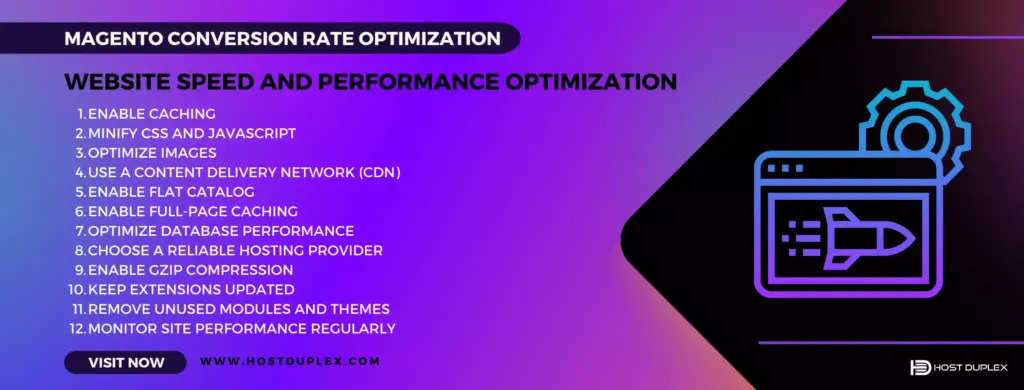
Website speed and performance are crucial in user experience and conversions on Magento websites. Slow loading times can lead to frustration and abandonment, resulting in lost sales opportunities.
In fact, studies have shown that even a one-second delay in page load time can result in a 7% decrease in conversions.
Furthermore, a faster website provides users with a smoother browsing experience, allowing them to navigate products more efficiently. This increases the likelihood of converting visitors into customers and encourages repeat purchases by creating a positive impression of your brand.
Strategies for Optimizing Magento Websites for Speed and Performance
Optimizing your Magento website for speed and performance is essential for providing a seamless user experience and increasing conversion rates. Here are some strategies to help you achieve that:
- Enable caching: Utilize Magento’s built-in caching feature, such as Varnish Cache or Redis, to store frequently accessed data and reduce server load.
- Minify CSS and JavaScript: Compress your CSS and JavaScript files by removing unnecessary characters, whitespace, and comments. This will reduce file size and improve loading speed.
- Optimize images: Large image sizes can significantly slow down your website. Resize and compress images without compromising quality using Photoshop or image optimization extensions.
- Use a content delivery network (CDN): A CDN distributes your website’s static content across multiple servers worldwide, reducing latency by serving content from the nearest server to the user’s location.
- Enable flat catalog: Enabling a flat catalog in Magento reduces the number of database queries required to fetch product information, resulting in faster page load times.
- Enable full-page caching: Implementing full-page caching generates static HTML versions of your web pages, eliminating the need for database queries during subsequent visits.
- Optimize database performance: Regularly optimize your Magento database by removing unnecessary log data, cleaning up orphaned entries, and reindexing whenever necessary.
- Choose a reliable hosting provider: Select a reliable hosting provider like Host Duplex that offers optimized servers specifically designed for Magento websites, ensuring fast loading speeds and minimal downtime.
- Enable Gzip compression: Enable Gzip compression on your server to reduce the size of transmitted data between the server and the user’s browser.
- Keep extensions updated: Regularly update all installed extensions to ensure compatibility with new versions of Magento and optimize their performance.
- Remove unused modules and themes: Disable or uninstall any unnecessary modules or themes that can slow down your website unnecessarily.
- Monitor site performance regularly: Use tools like Google PageSpeed Insights or GTmetrix to regularly analyze your website’s performance and identify areas for further optimization.
Also read, Magento Speed Optimization: 10 Expert Tips & Best Practices
2. Optimizing Search Functionality
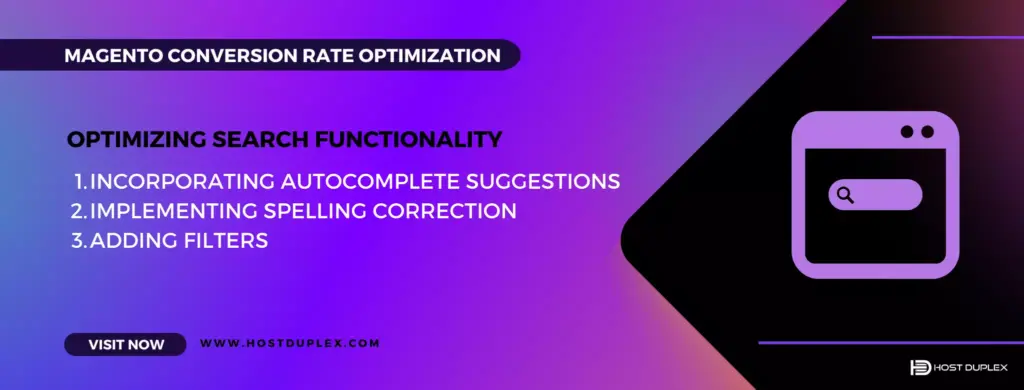
A well-optimized and personalized site search function can significantly enhance the user experience, leading to higher conversion rates. This is particularly true for Magento stores, where customers often rely on the search function to navigate through a wide array of products.
The built-in search functionality of Magento is good, but it has a comparatively poor search engine. For example, the search experience can be enhanced by:
- Incorporating autocomplete suggestions, which can guide your customers to the desired products more quickly.
- Implementing spelling correction to ensure that minor typos don’t hinder the search process.
- Adding filters to help customers narrow down their search based on various parameters like price, brand, or reviews.
However, the real game-changer comes when you integrate third-party Magento search optimization extensions into your Magento site. These advanced search engines can significantly enhance the search experience and bring desired search features.
For example, Elasticsearch, a popular third-party search engine, offers features like full-text search, distributed search, and multi-language support. It also uses a structure based on documents instead of schema or tables, making it more flexible and providing faster search responses.
3. Optimizing Product and Category Pages
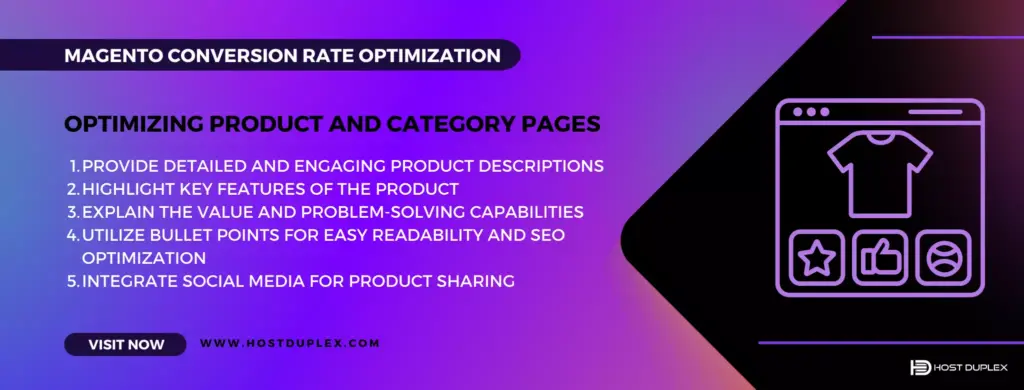
Product pages are the final touchpoint before a customer makes a purchase decision, so making them as user-friendly as possible is essential. To enhance the UX of product pages:
- Start by providing detailed and engaging product descriptions.
- Highlight the key features of the product.
- Explain how your product can solve a problem or add value to the customer’s life.
- Use bullet points for easy readability and include keywords naturally to improve SEO.
- Social media integration to share your products.
Magento’s features and extensions can greatly help optimize your product pages. For instance, you can use extensions like Magento 2 Product Zoom to add a zoom effect to your product images or Magento 2 Product Video to add videos to your product pages. These features can make your product pages more interactive and engaging, thereby improving your conversion rates.
Try to provide all the necessary information that customers might need to make a purchase decision without overwhelming them. A well-optimized product page improves conversions and enhances the overall user experience, leading to higher customer satisfaction and loyalty.
4. Utilizing High-Quality Images and Videos
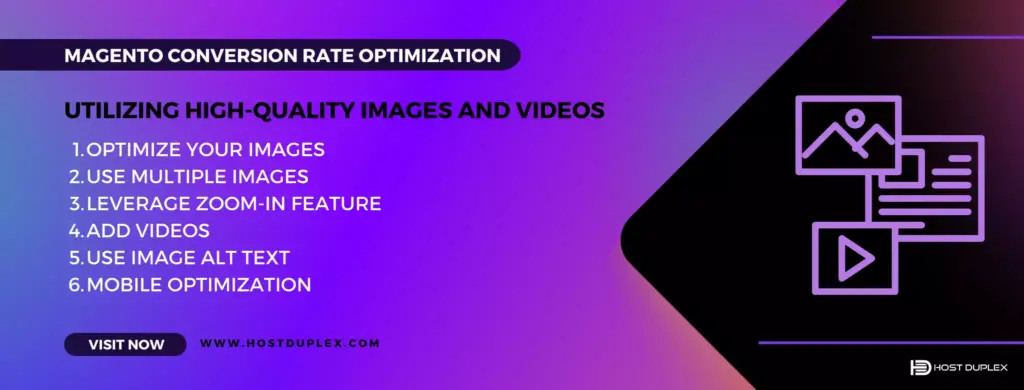
The adage “a picture is worth a thousand words” couldn’t be more accurate in eCommerce. High-quality images and videos play a pivotal role in conversion rate optimization. They enhance the aesthetic appeal of your Magento store and provide customers with a more detailed view of your products, leading to informed purchasing decisions.
Enhancing the User Experience (UX) of both product pages and the entire Magento site demands captivating yet optimized product images captured from multiple angles. This entices consumers to engage attentively, fostering a desire to explore the product in-depth.
A study by MDG Advertising reveals that 67% of consumers consider clear, detailed images to carry more weight than product information or customer ratings. This underlines the importance of high-quality visuals in eCommerce.
How to effectively use images and videos in Magento?
Magento offers various features and extensions to use images and videos for your products effectively. Here’s how you can leverage them:
1. Optimize Your Images:
Magento provides built-in tools to optimize your images. You can adjust your images’ size, format, and quality without compromising their visual appeal. Remember, while high-resolution images are crucial, they should not slow down your site’s loading speed. Therefore, balancing quality and performance is key.
Magento also supports many image optimization extensions that offer advanced features.
2. Use Multiple Images:
Showcase your products from various angles. This gives customers a comprehensive view of what they’re about to purchase, reducing doubts and potential returns.
3. Leverage Zoom-In Feature:
Magento allows you to add a zoom-in feature to your product images. This lets customers examine the product closely, replicating the in-store experience.
4. Add Videos:
Videos can be a game-changer for your Magento store. They provide a dynamic view of your products, making your listings more engaging. Magento allows you to embed videos from platforms like YouTube and Vimeo directly into your product pages.
5. Use Image Alt Text:
Image alt text improves your site’s SEO, making your products more discoverable. It’s a small piece of text that describes the image, helping search engines understand your content.
6. Mobile Optimization:
Ensure your images and videos are optimized for mobile devices. With more customers shopping on their phones, this is a crucial aspect of your Magento store’s performance.
5. Integrating Social Proof and Customer Reviews
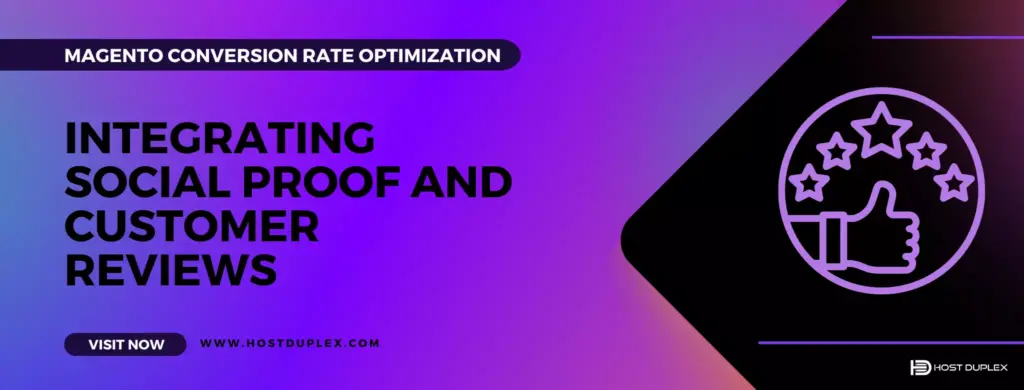
Social proof and customer reviews have a significant impact on purchase decisions, making them powerful tools for increasing conversions on Magento websites.
Social proof and customer reviews have a powerful influence on purchase decisions, making them essential elements for improving conversion rates on Magento websites. When potential customers see positive feedback from satisfied buyers, it creates trust and confidence in your brand.
According to a survey, 88% of consumers consider online reviews as trustworthy as personal recommendations.
Integrating customer reviews and social proof elements into Magento stores can significantly impact conversions. Displaying star ratings, testimonials, or user-generated content helps potential customers feel more secure about their purchase decision.
Furthermore, enabling social sharing options allows customers to share their positive experiences with others through social media platforms.
6. Implementing a Mobile-First Approach
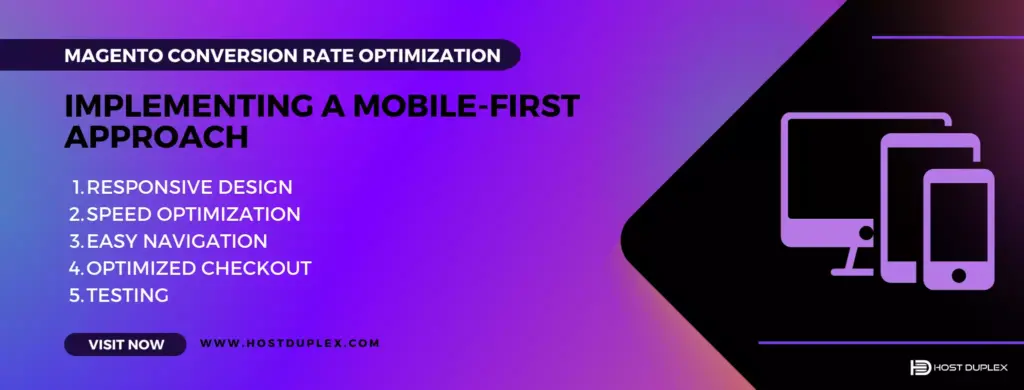
The world is rapidly shifting towards mobile, and your Magento store needs to keep up. Mobile commerce, or m-commerce, is shopping online through smartphones or tablets. It’s not just a trend; it’s a necessity.
Why is Mobile Optimization important for Magento?
Mobile commerce is no longer a luxury but a necessity for online businesses. According to a report by Tidio, m-commerce sales are projected to exceed $510 billion in 2023 and $710 billion in 2025. This significant growth is attributed to the convenience of shopping on mobile devices and the increasing number of mobile users. In fact, by 2024, there will likely be over 187 million active mobile shoppers in the US alone.
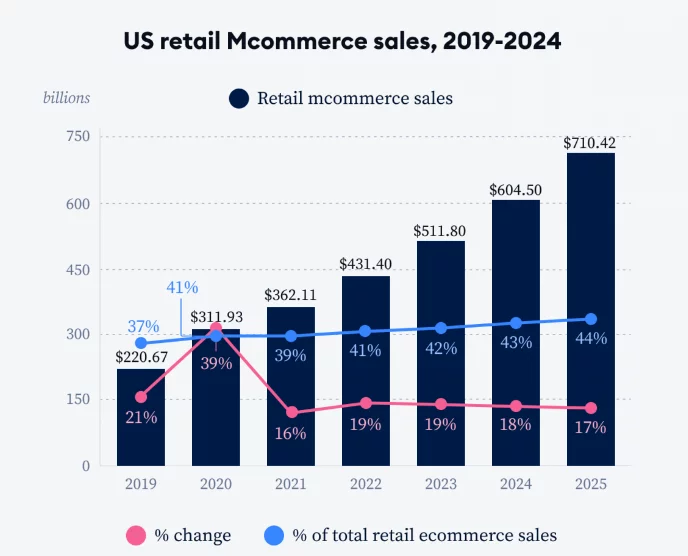
Moreover, almost half (49%) of mobile users compare the pricing of products or services on their smartphones. This indicates that a potential customer’s first interaction with your eCommerce site is likely on a mobile device. Therefore, optimizing your Magento store for mobile devices is a must to capture this growing market and improve your conversion rate.
How to Optimize Magento Stores for Mobile Devices Users?
Optimizing your Magento store for mobile devices involves several steps:
- Responsive Design: Ensure your website design is responsive, meaning it automatically adjusts to fit the screen size of the device it’s being viewed on. This provides a seamless browsing experience for users, regardless of the device they’re using.
- Speed Optimization: Mobile users expect fast loading times. Optimize your site’s speed by compressing images, using a content delivery network (CDN), and minimizing JavaScript and CSS files.
- Easy Navigation: Make sure your site’s navigation is simple and intuitive. Mobile screens are smaller, so it’s essential to have a clean, uncluttered design.
- Optimized Checkout: The checkout process should be streamlined and straightforward. Reduce the steps required to complete a purchase and offer multiple payment options, including mobile wallets.
- Testing: Regularly test your mobile site’s performance and functionality. Use tools like Google’s Mobile-Friendly Test to identify and fix any issues.
7. Personalizing User Experience
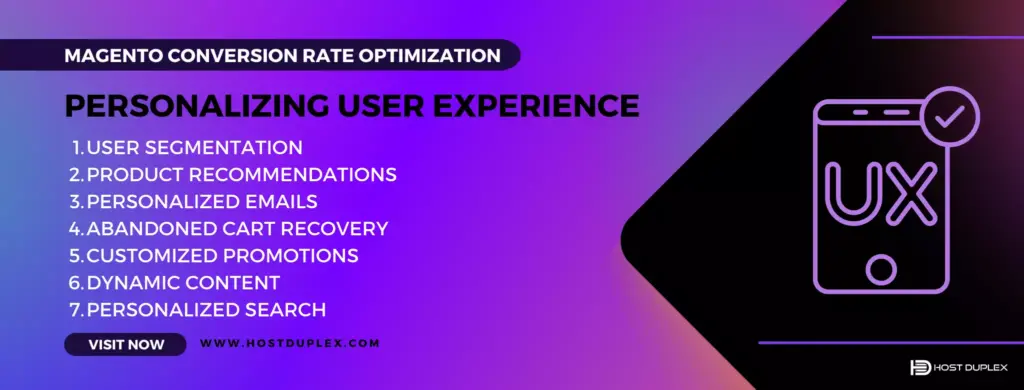
Personalization is a powerful tool in the eCommerce world, and Magento offers many options to help store owners create unique, tailored experiences for their customers. Personalization aims to make your customers feel special and catered to. The more personalized your Magento store is, the more likely your customers are to make a purchase and become loyal customers.
Personalization is the practice of showing content, products, or other digital touchpoints to a specific set of users or a single user with the goal of increasing relevance. The one-size-fits-all approach is no longer viable, and consumers expect a personalized experience, whether that’s on a website, in an email message, or on social media.
According to Gartner Research, 87% of marketers include personalization in their marketing strategy. The reason for this is simple: personalization provides a better customer experience. It immerses customers in the experience and makes them feel more comfortable with what is being offered. This drives customer engagement, conversions, sales, and long-term customer loyalty.
How to Personalize User Experience in Magento?
Magento offers several ways to personalize the user experience. Here are some strategies you can implement:
- User Segmentation: Magento allows you to segment your customers based on various factors like demographics, purchase history, and browsing behavior. This helps you to deliver more relevant content and offers to different customer groups.
- Product Recommendations: You can use Magento’s product recommendation feature to suggest products based on a customer’s past purchases or browsing history. This not only enhances the shopping experience but also increases the chances of additional sales.
- Personalized Emails: Magento integrates with various email marketing platforms that allow you to send personalized emails to your customers. These emails can include product recommendations, personalized offers, and more.
A well-executed email marketing campaign, supported by marketing professionals, holds the potential to enhance conversion rates significantly. By specifically targeting customers, the campaign aims to entice them to return to their abandoned carts and make a complete checkout process. - Customized Promotions: With Magento, you can create customized promotions for different customer segments. For example, you can offer a special discount to customers who have not made a purchase in a while.
- Dynamic Content: Magento allows you to display dynamic content based on user behavior. For example, you can show different homepage banners to different customer segments.
- Personalized Search: Magento’s search functionality can be customized to show personalized results based on a customer’s past searches and preferences.
8. Streamlining the Checkout Process
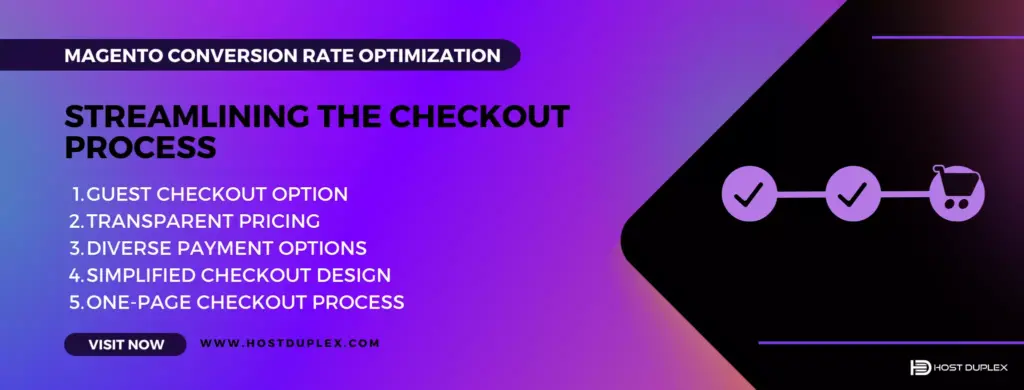
The checkout process is the final hurdle between a potential customer and a completed sale. It’s a critical part of the customer journey, and any friction or complexity can lead to cart abandonment, negatively impacting your conversion rate.
Why is a Smooth Checkout Process in Magento CRO Important?
According to a study by the Baymard Institute, nearly 70% of online shopping carts are abandoned before the purchase is completed. One of the primary reasons for this high abandonment rate is the complicated or lengthy checkout process.
A streamlined checkout process is a sweet checkout process strategy that can significantly improve your Magento store’s conversion rate. It reduces the time and effort required for customers to complete their purchases, leading to a more satisfying shopping experience. This satisfaction can increase customer loyalty, repeat purchases, and overall revenue.
Common Mistakes in the Checkout Process and How to Avoid Them
Several common mistakes can complicate the checkout process and deter customers from completing their purchases. These include:
- Forcing customers to create an account: Many customers prefer to checkout as guests, especially if they’re in a hurry or shopping from a store for the first time. Offering a guest checkout option can help reduce cart abandonment.
- Hidden costs: Unexpected costs, such as shipping fees or taxes, can surprise customers at the checkout and lead them to abandon their carts. Be transparent about all costs upfront to avoid this.
- Limited payment options: Not everyone uses the same payment methods. Offering a variety of payment options, including popular ones like PayPal and regionally popular payment gateways, can cater to a wider range of customers. Magento site owners must define payment method strategies for regionally popular payment gateways to suit their target audience.
- Complex checkout design: A confusing or complicated checkout design can frustrate customers. Keep the design simple and intuitive, with clear instructions and minimal steps.
Creating a One-Page Checkout Process in Magento
Magento offers robust checkout features and extensions that can help streamline the checkout process. One such feature is the one-page checkout, which consolidates the entire checkout process onto a single page. This reduces the number of steps and pages a customer has to navigate, making the process quicker and easier.
Another useful feature is the ability to save customer information for future purchases. This allows returning customers to checkout faster, as they don’t have to re-enter their information each time.
Several Magento extensions can also enhance the checkout process. For example, the ‘Magento 2 One Step Checkout‘ extension simplifies the checkout process by combining all checkout steps into one and providing customers with a quick and easy checkout experience. It also offers additional features like auto-suggest addresses, order comments, delivery dates, and more.
9. Ensuring Secure Payment Methods

The security of payment methods is a critical factor in conversion rate optimization. A secure payment process protects your customers’ sensitive information and builds trust, which can significantly improve your conversion rates.
The Importance of Secure Payment Methods in CRO
When customers shop online, they want to be sure that their financial information is safe. If they have any doubts about the security of your payment process, they may abandon their cart, leading to a loss in potential sales. Therefore, ensuring secure payment methods is a crucial part of conversion rate optimization.
According to a study by Baymard Institute, 18% of US online shoppers abandoned a cart in the last quarter because they didn’t trust the site with their credit card information. This statistic highlights the importance of secure payment methods in the conversion process.
Popular Payment Gateway Integration in Magento
Magento supports a wide range of payment gateways, making it easier for you to offer secure payment options to your customers. Some of the most popular payment gateways that you can integrate with your Magento store include PayPal, Authorize.Net, and Braintree.
For example, PayPal payment gateway is a globally recognized payment gateway that offers a secure and convenient payment process. It also provides a feature called PayPal Express Checkout, allowing customers to complete their payment without leaving your website, providing a seamless shopping experience.
You might also want to read, Stripe vs PayPal: Which Payment Processor is Better?
How to support multilingual and multi-currency features in Magento?
To cater to a global customer base, supporting multiple languages and currencies in your Magento store is important. Magento allows you to set up multiple currencies for your store, and you can display prices in the local currency of your customers. This not only improves the shopping experience for your customers but also enhances your store’s credibility.
However, it’s important to note that while Magento allows you to display prices in different currencies, the actual payment is processed in your store’s base currency. You’ll need to use a payment gateway that supports multi-currency payments, such as PayPal, to process payments in multiple currencies.
10. Implementing Effective Call-to-Actions (CTAs)
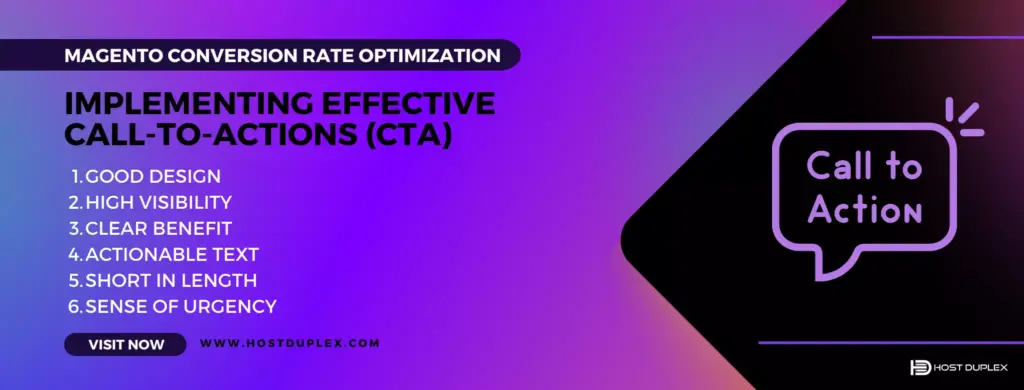
Call-to-Action (CTA) is an essential conversion tool that is important in guiding users to take the desired action, aligning with the essence of conversion itself. CTAs are the final nudge that prompts users to take a specific action, be it signing up for a newsletter, making a purchase, or downloading a resource. In the context of a Magento store, CTAs play a pivotal role in driving conversions and enhancing the overall user experience.
CTAs are essentially prompts on a website that guide users toward a specified action. They typically take the form of a button or hyperlink, with action phrases such as ‘Buy Now‘, ‘Sign Up‘, or ‘Add to Cart‘. The importance of CTAs in driving conversions cannot be overstated. They act as signposts, guiding users on what to do next. Without clear CTAs, users may not know the next steps to take, leading to a potential loss of sales or engagement.
For instance, if a user lands on a blog post on your Magento store and there’s no clear CTA at the end, they are likely to leave the site without taking any further action. However, if there’s a CTA encouraging them to explore more products or sign up for a newsletter, they are more likely to continue interacting with your site.
How to create strong and clear CTAs?
Creating compelling CTAs involves a combination of good design, high visibility, clear benefits, actionable text, brevity, and a sense of urgency. Here are some strategies to create effective CTAs:
- Good Design: CTAs should grab the user’s attention. Using a bright button color that contrasts with the page color can be an effective strategy.
- High Visibility: The CTA should be the most noticeable element on the page. Ensure the font size is large enough to command attention.
- Clear Benefit: State clearly what the user will gain from completing the action. This can improve click-through rates.
- Actionable Text: Use action words such as ‘discover’, ‘learn more’, and ‘buy now’ to compel users to take action.
- Short in Length: A good CTA should be a short phrase, not a sentence. Most effective CTAs are no longer than five to seven words.
- Sense of Urgency: Creating a sense of urgency can compel users to take immediate action.
How to leverage CTAs for better conversion rates in Magento?
You can leverage CTAs in various ways to improve conversion rates in Magento. For instance, you can place CTAs strategically across your site, such as on product pages, in blog posts, or even in the header or footer. You can also experiment with different CTA designs and texts to see what works best for your audience.
Remember, every audience responds differently to various CTAs. Therefore, testing the effectiveness of your CTAs is crucial. You can use A/B testing platforms to compare the performance of different CTAs and optimize for those with the highest conversion rates.
11. Managing Orders and Shipping Efficiently
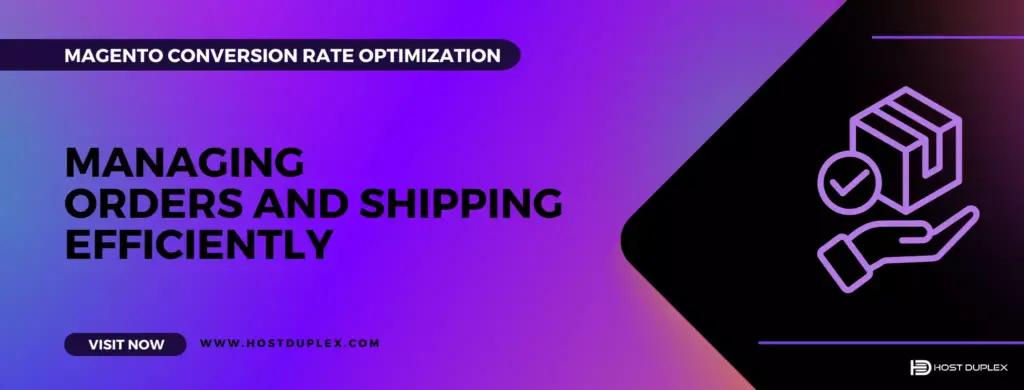
The conversion rate optimization journey doesn’t end when a customer clicks the ‘buy‘ button. In fact, the adventure is just beginning. Managing orders and shipping plays a pivotal role in optimizing conversion rate. It’s not just about getting the product to the customer; it’s about their experience, from confirming their order to receiving their package.
The Role of Order and Shipping Management in CRO
Efficient order and shipping management can significantly impact your Magento store’s conversion rates. Ecommerce Nation highlights that efficient order management can lead to increased customer loyalty. When customers receive their orders on time and in perfect condition, they are more likely to return to your store for future purchases.
Providing Real-Time Order Updates and On-Time Delivery
Customers expect real-time updates on their orders. They want to know when their order has been processed when it has been shipped, and when they can expect to receive it. Providing this level of transparency can significantly enhance the customer experience, leading to higher conversion rates.
On-time delivery is another crucial aspect of order and shipping management. According to Ecommerce Nation, late deliveries can lead to negative customer reviews, harming your store’s reputation and deterring potential customers. Therefore, ensuring your products reach your customers on time should be a top priority.
Leveraging Magento’s Features for Efficient Order and Shipping Management
Magento offers a variety of features and plugins that can help streamline your order and shipping management process. For instance, the Magento Order Management System (OMS) provides a centralized platform for managing all aspects of the order lifecycle, from order capture and validation to shipment and settlement. This system can help you deliver your customers a seamless and efficient shopping experience, thereby improving your conversion rates.
In addition, Magento’s integration with various shipping carriers allows you to provide real-time shipping rates to your customers, enabling them to choose the most convenient and cost-effective shipping option. This can enhance the customer experience and increase the likelihood of conversion.
Furthermore, there are many Magento extensions available that can enhance your order and shipping management process. For example, the Amasty Order Status extension allows you to create custom order statuses to provide your customers with more accurate and detailed order updates. Similarly, the Mageplaza Order Export extension enables you to easily export order data for analysis and reporting, helping you identify areas for improvement.
12. Offering a Seamless Return Policy
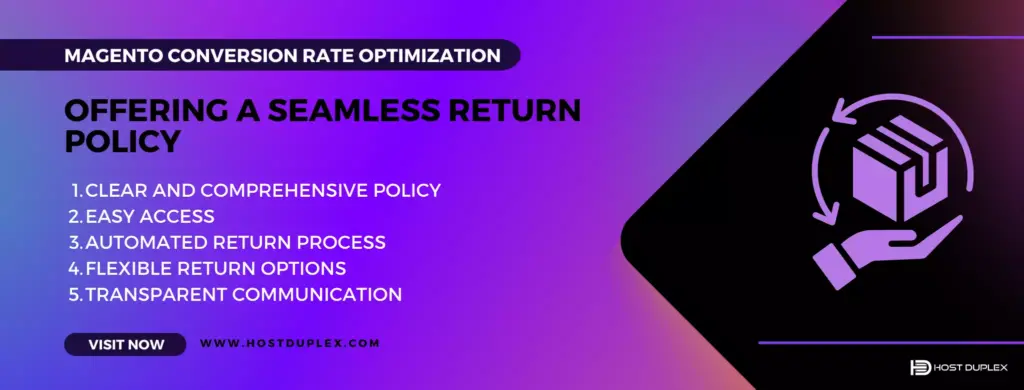
A seamless return policy can serve as a safety net for customers, assuring them that they can return a product if it doesn’t meet their expectations. This assurance can help reduce purchase hesitation and increase the likelihood of conversion. Furthermore, a transparent and easy-to-understand return policy can enhance customer trust and loyalty, leading to repeat purchases and higher lifetime customer value.
A study by Narvar found that 49% of shoppers check a retailer’s return policy before making a purchase, and 96% would shop with a retailer again based on an “easy” or “very easy” return experience. This clearly indicates that a well-crafted return policy can significantly improve your conversion rate.
How to Offer a Seamless Return Policy in Magento?
Magento provides various options to manage return policies effectively. Here are some steps you can take to offer a seamless return policy in your Magento store:
- Clear and Comprehensive Policy: Your return policy should be easy to understand and find. It should clearly state what items can be returned, the return timeframe, the return process, and who pays for return shipping. Make sure to use simple language and avoid legal jargon.
- Easy Access: Place your return policy in a prominent location on your website, such as the footer or the customer service page. Also, consider including a link to your return policy on product pages and during the checkout process.
- Automated Return Process: Use Magento extensions like RMA (Return Merchandise Authorization) to automate the return process. These extensions allow customers to submit return requests directly from their account dashboards, making the process easier and more efficient.
- Flexible Return Options: Offer multiple return options such as refund, store credit, or exchange. This flexibility can enhance customer satisfaction and encourage future purchases.
- Transparent Communication: Keep your customers informed about the status of their return and refund through email notifications. This transparency can enhance customer trust and improve their overall shopping experience.
Testing and Measuring Magento CRO Strategies
The journey to conversion rate optimization doesn’t end with the implementation of strategies. Testing and measuring these strategies’ effectiveness is crucial to ensure they deliver the desired results. This is where conversion rate optimization tools like Google Analytics come into play.
A/B testing, or split testing or bucket testing, is a popular method used to compare two versions of a webpage or app to determine which one performs better. This methodology involves showing users two or more page variants at random and using statistical analysis to determine which variation performs better for a given conversion goal. For A/B testing, you can choose some options like Optimizely.
The process of A/B testing involves several steps:
- Collect data: Use your analytics tool, such as Google Analytics, to identify your site’s or app’s high-traffic areas for optimization. Look for pages with high bounce or drop-off rates that can be improved.
- Identify goals: Your conversion goals are the metrics you use to determine whether the variation is more successful than the original version. Goals can be anything from clicking a button or linking to product purchases.
- Generate test hypothesis: Once you’ve identified a goal, you can begin generating A/B testing ideas and hypotheses for why you think they will be better than the current version.
- Create different variations: Using your A/B testing software, make the desired changes to an element of your website or mobile app. This might be changing the color of a button, swapping the order of elements on the page, or something entirely custom.
- Run experiment: Kick off your experiment and wait for visitors to participate! Visitors to your site or app will be randomly assigned to either the control or variation of your experience. Their interaction with each experience is measured and compared to determine how each performs.
- Analyze results: Once your experiment is complete, it’s time to analyze the results. Your A/B testing software will present the data from the experiment and show you the difference between how the two versions of your page performed and whether there is a statistically significant difference.
This process helps you make data-informed decisions, shifting business conversations from “we think” to “we know.” By measuring the impact that changes have on your metrics, you can ensure that every change produces positive results.
How Can Magento Hosting Services Improve Your Conversion Rate?
A reliable Magento hosting service like Host Duplex is designed to support the implementation of these strategies and improve conversion rates. With a robust infrastructure, advanced security measures, and 24/7 support, we ensure your Magento store runs smoothly and efficiently. This allows you to focus on implementing the conversion rate optimization strategies we’ve discussed, knowing that your site’s performance is in good hands.

Bottom Line
Magento conversion rate optimization can be improved significantly by understanding your audience, setting realistic goals, conducting regular audits, defining payment method strategies, and implementing the advanced strategies we’ve discussed.
Remember, continuous testing and measurement are key to successful conversion rate optimization. Tools like Google Analytics and A/B testing methodologies can provide invaluable insights into the effectiveness of your strategies. We encourage you to implement these strategies and share your experiences.



The Best Magento Conversion Rate Optimization Strategies (2023)